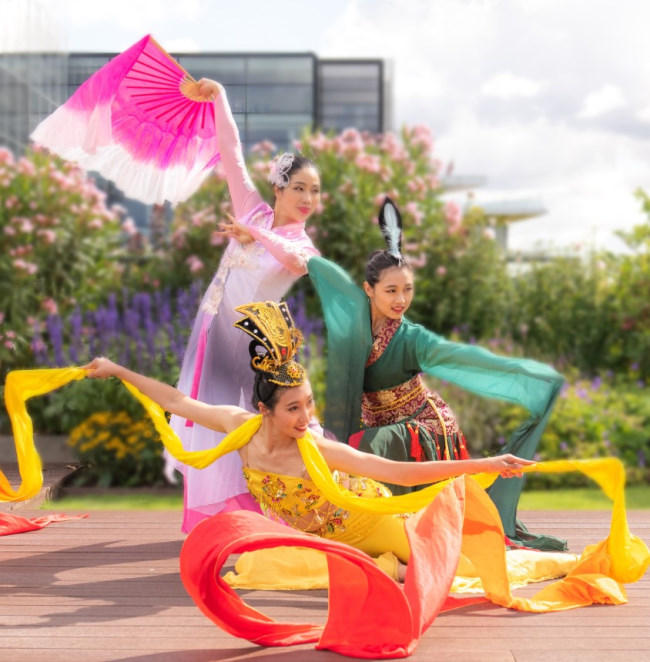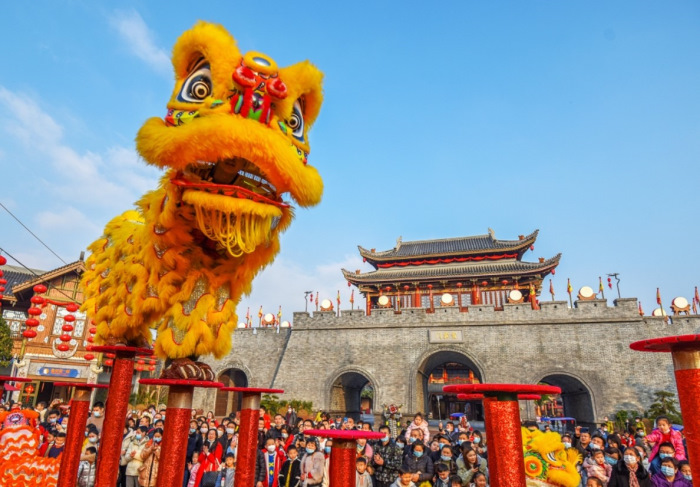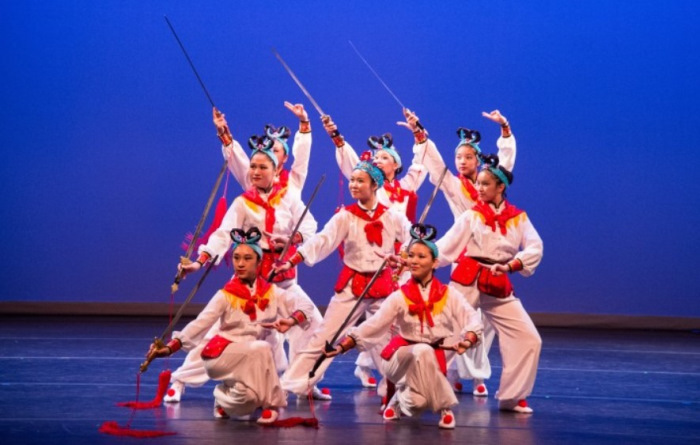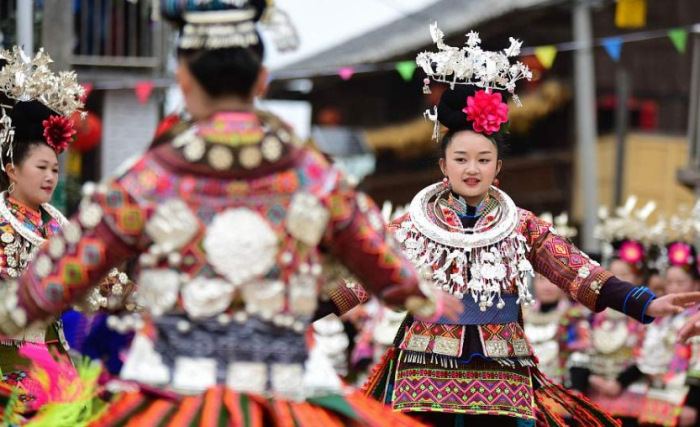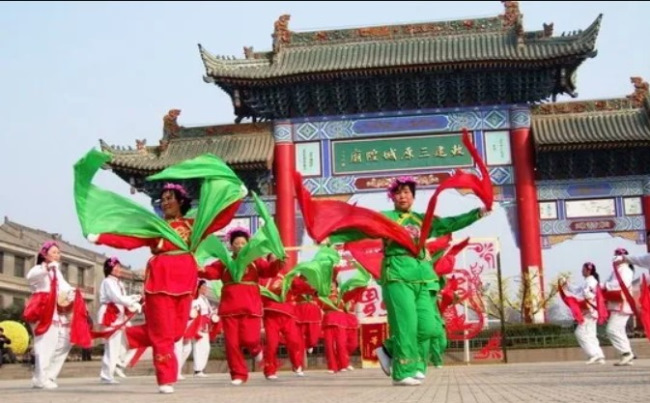Dance is an integral part of Chinese culture and history. There are various types of traditional Chinese dance, each of which carries a historical story, a purpose, a costume type, and a cultural meaning.
Let’s learn about the origin of Chinese traditional dance and see how each traditional dance style differs from the other.
Table of Contents
Chinese Traditional Dance History
The first dance appeared 5,000-6,000 years ago, in the Neolithic Age. In this early time, dance was born as a form of religious ritual, not for entertainment purposes.
The dance’s content was to reflect human labor and reproduction as the daily life of humans at that time. Dance in this period is Se (a five-string instrument) and bone flute.
Zhou dynasty marked the fast development of traditional Chinese dance. Dance in this period was also known as “Yue Wu” with the music performance “Ya Yue”, and had the purpose of supporting rites and large-scale religious ceremonies. In this period, there are 2 schools of dance, “Big Dance” and “Small Dance”.
It wasn’t until the Han dynasty did dance become a form of entertainment. In this period, a lot of professional training and new music gadgets were used to support dance performances.
But the peak development happened in the Tang dynasty. The dance in the Tang dynasty was built based on “Hundred performance” as the foundation of the Han dynasty. Plus, this dance was also a great combination of Chinese culture and foreign culture in the Age of fragmentation.
After the Tang dynasty, Chinese folk dance as an art form declined with the disappearance of many ancient dances. Dances began to blend into opera dance, a form of entertainment that took shape in the Song and Yuan dynasties and then was popular in the Ming and Qing dynasties.
Today, many traditional dances of Chinese culture have resurgent. Plus, new and modern Chinese dances are growing fast.
Characteristics Of Traditional Chinese Dance Styles
From lion dance to fan dance, traditional Chinese dance styles share some common characteristics:
- Rapid, stylized movements: in Chinese folk dance, there is a mutual pattern in every step and gesture.
- Circular movement: the dancer’s body moves fluidly and roundly in a circular form with the smooth cooperation of hands, arms, head, and feet. There is a lot of torso bending and traveling across the stage. Noticeably, there is close coordination between hands and eyes.
- Musicality: music determines every movement and every gesture in a dance performance.
- Props: props are a vital part of the dance besides traditional Chinese dance costumes. Some popular props are hoops, fans, banners, ribbons, etc.
- Emotion as motivation: key emotions, including pleasure, joy, anger, and sorrow, provides the motivation for movements. Emotion is released and expressed in the body’s gestures to tell a story. For this reason, Chinese dance is immensely expressive.
Famous Types Of Traditional Chinese Dance
Chinese Fan Dance
Fan dance, or 扇子舞 (shànziwǔ) which refers to the dance with a fan as the main prop, is one of the most famous types of Chinese folk dances.
In a fan dance, fans are used as an extension of the dancer’s hands, to accentuate the dancer’s movement, and to embrace beauty and grace.
While the military fan dances are for training purposes, the civilian fan dances (or fan dances) are for entertainment purposes. The first fan dance (or Hani fan dance) was performed during the Han Dynasty.
Up till now, the Hani fan dance is popular in Yuanjiang, Honghe, Yuanyang, and Xinping counties of Yunnan Province. Besides Hani, the fan dance is also popular in other ethnic groups, like the Han and Korean.
There are 2 types of Hani fan dance – brown fan dance and paper fan dance.
In the brown fan dance, dancers are mostly women. They use palm leaf or banana leaf fans to replicate the silver pheasant. This dance is gentle, showing the adoration for the village god’s grandmother and expressing the good wishes and ideals of the Hani.
On the other hand, the paper fan dance is an upgraded version of the brown fan dance and is mainly performed by men at funerals (around 2, 4, or many people in pairs). This dance has a slow rhythm, and most of the dance describes the movements of the birds.
Dragon Dance – Most well-known traditional Chinese Dance
The dragon dance, the “descendants of the dragon”, or 舞龙 (wǔlóng), is the most worldwide well-known type of dance as it’s often recreated for Chinese Spring Festival celebrations.
Besides, this dance is also performed in other traditional Chinese festivals like the Chinese Lunar New Year and Lantern Festival or praying for rain. Because of its popularity, the dragon dance is also considered a symbol of the Chinese national spirit.
This dance first appeared in the Han dynasty (206BC – 220AD). Since then, there are many records of dragons in this dance, from the Han, Tang, Ming, and Qing dynasties.
The dragon is an animal created by Chinese people. It stands for good fortune and power. In the dragon dance, the longer the dragon, the luckier it will be (some dragons can be 100 meters long!). A dragon can have many joints so that dancers can make twists and prances.
In the festivals of Chinese people all around the world, you can see many variations of the dragon. For example, the “Baiye dragon” with many blossoming loti, the “human body dragon”, “fire dragon”, “hand dragon”, etc.
Lion Dance
The lion dance is among the most distinctive forms of dance in Chinese cultural arts. You can see the basic movements of this dance in many Chinese martial arts as a form of wishing for good fortune.
To perform a lion in a lion dance, there should be from 2 to 3 people – one in the head position, another one in the tail, and the third one wearing a mask act as “Happy Buddha”.
The lion dance isn’t the same between the North and South of China.
In Northern China, the lion dance has to perform many dangerous stunts and acts as a form of entertainment for the imperial court. This lion has 3 basic colors – red, yellow, and orange.
However, the lion dance in Southern China brings more symbolic meaning and is often performed as a ceremony to scare away evil spirits and wish for fortune and luck. The lion in the Southern lion dance has more lively colors. Its head has large eyes, with a mirror on the forehead and a horn at the center of the head.
While the lion dance and the dragon dance look similar, there are some key differences between these two types of dance.
- First, while there are 2-3 people needed to perform a lion dance, there are at least 10 people required to perform a dragon dance.
- Second, the dancer in the head position of a lion dance keeps his face hidden, while in a dragon dance can show his face as the dragon is held in poles.
Check more: Zouk Dance
Long Sleeves Dance
The long sleeves dance is a mixture of opera and dance with unique beauty. It is listed among the 4 great effects of the Chinese Peking Opera.
Long sleeves dance was derived from ancient Chinese dance and became popular in the Han and Tang dynasties. This type of dance focuses on the body rhythm, sways, unique verve, and technique charm.
Mongolian Dance
Mongolian dance was born in expansive open lands of Mongol, with some props such as chopsticks and bowls, and some parts of the costume are headpieces, belted, and embroidered robes.
There are some typical characteristics of Mongolian dance.
- First, the wide arms of the dancer describe the flight of the eagle.
- Second, his high-rearing back, stepping, and syncopated “gallops” are used as a respect to the equestrian lifestyle of the Mongols.
Nichang Yuyi
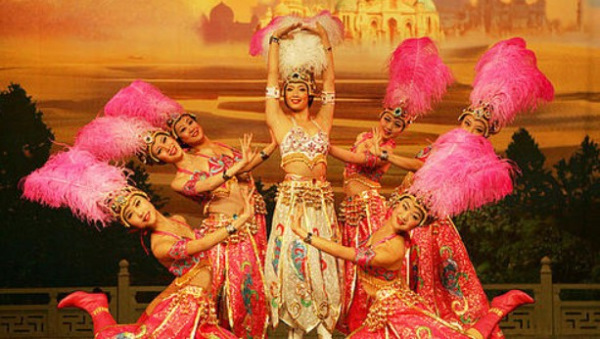
Nichang Yuyi (or the Song of Enduring Sorrow, Feather Dress Dance) is a Chinese court dance. This royal dance is created in the Tang dynasty, by Emperor Xuan Zong (privately known as Li Longji). The dance costume of Nichang Yuyi has feathers, which are fluttery and soft.
This dance describes a dream of an emperor, in which there is a group of beautiful virgins dancing in the skies. The dancers seem weightless and have graceful motions. When the emperor tells his dream to his concubine, the concubine reperforms the dance for him.
Peacock Dance – Ethnic Folk Dance
Peacock dance, 孔雀舞 (kǒngquèwǔ) is the most famous dance of the Dai ethnic group and is popular in Luxi, Ruili, and Xishuangbanna in Dehong Dai and Yunnan Province.
In Southeast Asian symbolism, peacocks are often connected with peace, heaven, elegance, and good fortune.
This dance was created based on the story of Dai leader Zhaoma Lijiesu learned to imitate the peacocks’ posture, which is fragile, flexible, and light. The performance begins with waking, looking for food, bathing in a river, and flying.
Nowadays, the dance is recreated by generations of dance arts and forms the modern peacock dance as today. Yang Liping is the most famous artist for peacock dancing, with 2 masterworks “Spirit of the Peacock” and “Love of the Peacock”.
Prince Qin’s Cavalry
Prince Qin’s Cavalry is a traditional dance to celebrate the grandeur and the might of the Imperial army. This dance is also a reminder to the entourage of the emperor to always be ready to protect the motherland.
For that purpose, Prince Qin’s Cavalry often takes place in a theater.
In this dance, there is a huge troupe of dance performers consisting of over a hundred dancers, soldiers, and many musicians and singers. The choreography and the music are set to a military cadence, while audiences are encouraged to beat their scabbards on the floor in accordance with the music.
There are 12 “acts” in a dance, describing the preparation for battles, the line-up in battle formations, and battle scenes.
Ribbon Dance
The traditional ribbon dance has its roots back in the Tang dynasty in the early 8th century, with Emperor Tang-Ming-Hwon and his consort Yang-Gwei-Fei as its 2 creators.
In Chinese legend, Emperor Tang-Ming-Hwon (or Tang Xuangzong) dreamed that he was in the moon palace enjoying many fairies singing and dancing in long, vivid-colored robes.
The noticeable part of this dance is the soft silk ribbons flowing in the music created by 2 musical instruments – Erhu and Pipa, creating a poetic and refreshing mood.
“The Dance of Nei Chang Yu Yi” (or Rainbow and Feather Dress Dance) was created then.
The ribbon dance can be performed solo, in a group dance, or pas de deux. The artists hold Fanjie and wear feathered costumes and emeralds. While dancing, they seem like a group of cranes flying in the cloud.
Sword Dance
Sword dance, or 剑舞 (jiànwǔ), originated from many cultures. It was first used as a training exercise for soldiers, then turned into acrobatic dance.
It is also among the 4 traditional dances in Chinese opera and also a regular dance in Tai Chi.
In the dance, the sword (the prob of this dance) has a tassel as an attachment. The sway of this tassel adds more enchantment to the sword.
The Miao Dance
The Miao dance is the traditional dance of the Miao (or the Hmong people), one of the oldest Chinese ethnic groups.
Silver in this dance is used to display the Miao wealth. It’s also a sign of social and economic status, a symbol of prosperity and happiness, and a talisman to keep off evil.
The jingling sound of silver accessories on a Miao dancer’s costume (necklaces, headdresses, bracelets, bells, and charms) blends well with the drumming sound to make a cheerful movement.
Moreover, the weight of those silver accessories drives the choreography. Various fast moves, like jump kicks, head swaying, etc. make the colorful pleated skirts flare.
Yangko Dance
The Yangko dance was created by working farmers in the Song Dynasty, with the purpose of wishing for a great harvest at that time.
For that reason, the dance has a smooth and compact rhythm, with abundant dance language, vivid dancing style, exuberant body gestures and dance language, and a jolly scene.
The traditional Yangko dance costumes are in vivid colors and are made based on theatrical costumes.
Years by, the original Yango dance constantly updated new forms and techniques from the Chinese culture to create variations, like folk Kungfu, folk songs, farming songs, acrobatics, and dramas in many regions and customs.
There are 3 performance types in the Chinese Yangko dance: Yangko on the ground, Yangko on the stilts, and song-and-dance duets.
Final Words
Traditional dances of China aren’t only diverse in their dance costumes, their symbolic meaning, and the purposes of dance, but also in how they are performed at different times in history.
Yet, they do have a common purpose – to use music and body movement to tell and share the Chinese lifestyle, beliefs, history, and culture.
This list only shares a part of the long story of traditional Chinese dance. There are a lot more dance styles that will be updated in the near future.
